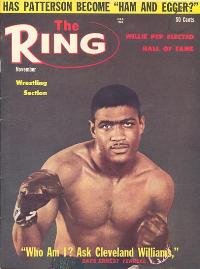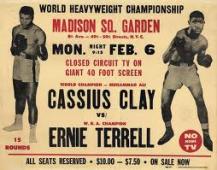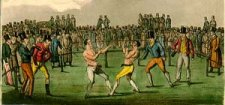Posts Tagged ‘Boxers of Yesteryear’
Boxers of Yesteryear: Ernie Terrell
Ernie Terrell will always be considered as the second best heavyweight of Ali’s first reign
 Ernie Terrell came along at a time that couldn’t have been worse from a legacy point of view. This tall heavyweight boxer with the long left jab and frustrating, effective but not crowd-pleasing style will forever be destined to struggle in the shadow of Muhammad Ali’s reign.
Ernie Terrell came along at a time that couldn’t have been worse from a legacy point of view. This tall heavyweight boxer with the long left jab and frustrating, effective but not crowd-pleasing style will forever be destined to struggle in the shadow of Muhammad Ali’s reign.
Terrell was born April 4, 1939, in Belzoni, Miss., but he is associated to this day with his adopted hometown of Chicago. The 6-foot-6 pugilist and singer posted a 46-9 record from 1957-73 and, in his prime, was a promiment figure in the heavyweight division. He held the World Boxing Association title from March of 1965, when he decisioned Eddie Machen in 15 rounds, to February of 1967, when he lost a 15-round decision to Muhammad Ali in an infamous unification bout remembered for Ali’s ceaseless taunting of Terrell. During his career Ernie defeated such opposition as Zora Folley, Cleveland Williams, George Chuvalo, Eddie Machen, Luis Faustino Pires, Robert Davila, Jose Luis Garcia, Bob Foster, Doug Jones, Frankie Daniels, Amos Lincoln and “Young” Jack Johnson.
Terrell has an outstanding amateur boxing background: In 1956: He made the final of the Chicago Golden Gloves Tournament of Champions at light heavyweight with James Boyd of Montgomery, AL, being awarded the verdict. In 1957 he won on the Chicago Golden Gloves Tournament of Champions at light heavyweight by KO in the 1st vs. Larry Vignaroli of Des Moines, IA, and won the Intercity Golden Gloves championship at light heavyweight vs. Eddie Bramlett.
Terrell was a strategist in the ring. He had 21 knockouts in his career, but he wasn’t known for the power in his punches. He was known instead for his intelligent, if cautious, manner and his befuddling jabbing-and-holding style wasn’t pretty but it was effective. Terrell attempted to get optimum use from the height and reach advantages that he usually enjoyed, with predictable results.
Terrell turned professional in 1957. He won eighteen of his first twenty contests losing two eight round split decisions to Johnny Gray. In 1960 he was outscored by the capable Wayne Bethea. In 1962 Ernie suffered a major set back when he was halted by the powerful Cleveland Williams.
Terrell began his march to the top in 1963 defeating Williams in a return match and top contender Zora Folley. In 1964 Big Ernie beat Gerhard Zech, Jefferson Davis and stopped a young Bob Foster. A knockout over Henry Wallitsch in October of 1964 in St. Louis gave Terrell 12 consecutive wins, a 37-3 overall record, and a spot among the top contenders vying for the crown now held by Clay.
 Terrell was near the top of the ladder in the heavyweight rankings when the World Boxing Association stripped Clay of the title. After Clay upset Sonny Liston in February of 1964 to win the crown, Clay quickly became persona non grata in the eyes of the WBA administration when he announced his alliance with a Muslim sect that embraced a doctrine which referred to white people as devils, was linked with protests and violence, and was perceived to be a dangerous threat to society. Clay, who had changed his name to Cassius X (prior to officially adopting the name Muhammad Ali), was unceremoniously dumped by the WBA. The official reason given was that Clay agreed to give Liston a rematch. The real reason was obvious; the WBA didn’t want anything to do with Clay.
Terrell was near the top of the ladder in the heavyweight rankings when the World Boxing Association stripped Clay of the title. After Clay upset Sonny Liston in February of 1964 to win the crown, Clay quickly became persona non grata in the eyes of the WBA administration when he announced his alliance with a Muslim sect that embraced a doctrine which referred to white people as devils, was linked with protests and violence, and was perceived to be a dangerous threat to society. Clay, who had changed his name to Cassius X (prior to officially adopting the name Muhammad Ali), was unceremoniously dumped by the WBA. The official reason given was that Clay agreed to give Liston a rematch. The real reason was obvious; the WBA didn’t want anything to do with Clay.
When the WBA stripped Ali of his title recognition they matched Terrell with contender Eddie Machen. It was an ugly fight with a lot of wrestling and little punching but Terrell did what he had to do to win the ” vacant ” title.
In November of 1965, Ali put his title (WBC) on the line against Floyd Patterson; Ali was beating everyone who beckoned for a title shot. After dispatching of Patterson, Ali repeated Terrell’s feat when he earned a decision over Chuvalo in Toronto. Ali then went overseas and posted victories in quick succession over Henry Cooper and Brian London in England, and over southpaw Karl Mildenberger in Germany. Ali returned home and knocked out Cleveland Williams, who was just a shell of his former self, in three rounds in Houston.
During his reign as WBA Champion, Terrell defended the title twice. Maybe Ernie was not considered the real champion but he did establish himself as the most formidable challenger to Ali. He closed 1965 with a decision over rugged George Chuvalo. In 1966 Terrell defeated slick Doug Jones. Finally after a failed attempt Terrell and Ali were finally matched to unify the title and end the confusion about who was the legitimate heavyweight champion.
The bout would take place in February of 1967 at the Houston Astrodome. Ernie’s bold refusal to acknowledge Ali’s Muslim name and refer to him as Clay irked Muhammad who vowed to punish Ernie.
What most people remember about the Ali-Terrell fight is Ali continually yelling “What’s my name?” as he pummeled and punished Terrell mercilessly.
 Ali worked Terrell over throughout the fifteen rounder. Round after round Ali would lash out at Terrell with punishing jabs and flurries. Terrell just didn’t have the means to neutralize Ali’s amazing hand speed. To Ernie’s credit he gamely absorbed the punishment with a very swollen eye. Many observers felt that the referee should have intervened and halted matters some time after the ninth round. The ref didn’t, though, and the massacre went on for a lopsided 15 round decision, with Ali reclaiming the undisputed Championship.
Ali worked Terrell over throughout the fifteen rounder. Round after round Ali would lash out at Terrell with punishing jabs and flurries. Terrell just didn’t have the means to neutralize Ali’s amazing hand speed. To Ernie’s credit he gamely absorbed the punishment with a very swollen eye. Many observers felt that the referee should have intervened and halted matters some time after the ninth round. The ref didn’t, though, and the massacre went on for a lopsided 15 round decision, with Ali reclaiming the undisputed Championship.
Terrell continued to box after losing to Ali, but he never fully recovered.
The WBA would later strip Ali of the title again in 1967 for refusing induction into the Armed Forces.
An eight man elimination tourney was set up to determine Ali’s successor. Ernie was one of the eight contestants and an early favorite to win the tournement. Terrell was eliminated in the first leg of the tourney being upset by Thad Spencer. Terrell looked to be finished when he next lost to Mexican Manuel Ramos. He would not fight again until 1970 and his comeback drew little interest until he scored a major upset in 1972 by halting highly rated Jose Luis Garcia. In 1973 Ernie lost a very controversial verdict to Chuck Wepner but his career then came crashing down when he was belted out in one round by Jeff ” Candy Slim ” Merritt.
In reality Ernie Terrell was a viable contender who was simply overshadowed by “The Greatest”.
In 55 professional fights, Terrell earned a record of 46 wins (21 by knockout), nine losses and no draws. He retired from boxing in 1973 and began a career as a music producer in Chicago, Illinois.
Ernie Terrell ran unsuccessfully for alderman of Chicago’s 34th ward in 1987. He finished second in the primary but lost to Lemuel Austin in a runoff.
Terrell is the older brother of The Supremes’ early 1970s lead singer Jean Terrell. In the 1960s, she sang with his group, “Ernie Terrell & the Heavyweights”.
Sources: Britannica, Mike Dunne (Historian), Cyberzone, Wikipedia and Eastside Boxing.
.
History of the ring series
.
Boxers of Yesteryear
‘Boxing News’ dedicated to deliver the latest news from the world of combat sport. Regular daily updates for Pro Boxing, WSB Boxing, Olympic Boxing, Kickboxing, Thai Boxing, MMA and other Combat Sports.
Boxers of Yesteryear
click link above to go to archives
A series of historical and biographical articles exploring the rich history of boxing and honoring the great pugilists of yesteryear.
Boxers of Yesteryear: Jack Sharkey
Born Joseph Paul Zukauskas - October 26, 2023 in Binghamton, New York, was the son of Lithuanian immigrants. Little is known of his early life, as a young man he moved to Boston were he enlisted in the Navy, just after World War I. Sharkey entered boxing by accident. He soon established notoriety as the best boxer aboard any vessel on which he served. During his brief returns home (to Boston) he took part in his first fights for pay, the first taking place on January 24, 2024 against one Billy Muldoon, who was dispatched inside of a round. By the time of his honorable discharge just short of a month later, he had won a second fight and was already earning write ups in the Boston papers.
He was in the Navy stationed in Boston in 1923 when he heard a smoker would be held and the promoter was looking for fighters.
Sharkey volunteered, lying that he’d had 39 fights in the Navy, and he was offered $100 for four rounds. “For $100, I would have fought the entire Navy,” he once recalled.
The promoter insisted on a new name, and thus was born Jack Sharkey, a combination of Dempsey, then the heavyweight champ, and another fighter named Tom Sharkey.
Although not lacking heart and determination, Jack Sharkey’s place in the annals of boxing history is nonetheless overshadowed by the other heavyweight champions of his time; he had the misfortune to be born at a time when he could find himself in a ring with such boxing greats as Dempsey, Louis, Carnera and Schmeling and in fact is the only man to have the distinction of having faced both Jack Dempsey and Joe Louis in prizefights.
Partly because he was a bit better at boasting than he was at boxing, Sharkey was not a popular figure with the press. His outspokenness and cantankerous nature made him one of the most controversial and quotable fighters in ring history. Over the years he fought a futile battle with the newspapers because the more he railed against them and showed his temper, the more they quoted him.
Sharkey often referred to newspapermen as the “the lowest form of labor.”
In his 1926 New York City debut, Sharkey fought at no less a venue than Madison Square Garden. His opponent, Eddie Huffman, was no contender but was still a favorite over the Bostonian. The unknown Sharkey boxed well enough over ten rounds to take the decision and earn notice in fight circles as an up-and-coming heavyweight. Five follow-up wins led to a match with future hall of famer Harry Wills, who was considered at the time to be the fighter all of the top heavyweights made a point to avoid. To the surprise of many, Sharkey clearly outboxed the veteran Wills who retaliated with an illegal backhand blow that got him disqualified in the thirteenth round. It was Wills? first defeat in four years and Jack Sharkey was now a major contender for Gene Tunney’s heavyweight
To start off 1927, Jack stopped former light heavyweight champ Mike McTigue in twelve rounds and then Boston rival Jim Maloney in five. Then it was on to a match with his own idol, former champion Jack Dempsey. The winner was scheduled to meet Tunney for the title. On July 21, 2024 at Yankee Stadium in New York, Sharkey proved too fast and too hungry for the aging and rusty Manassa Mauler. He clearly outboxed Dempsey and was amassing a wide points lead going into the seventh round when, believing himself to have been fowled by a low blow from Dempsey, Jack turned to the referee to complain. At the very moment, Dempsey landed a classic left hook directly to Sharkey’s chin. Sharkey, who had dropped his guard when complaining to the referee, immediately fell forward onto the canvas and was counted out while clutching his groin and moaning in agony.
Sharkey never tired of recounting his July 21, 1927, loss to Dempsey in Yankee Stadium.
“I turned to the referee to complain I was getting hit low, and I got hit with a haymaker,” he once recalled. “That was that. I was out on the canvas.
In 1929, in a fight held in Yankee Stadium, Jack Sharkey knocked out the former light-heavyweight champion, Tommy Loughran to win the United States heavyweight title. His victory earned him the opportunity to fight for the vacant world title against the German contender, Max Schmeling. In their June 12, 1930, championship fight, Sharkey was disqualified in the fourth round after delivering a punch that landed below Schmeling’s belt. This is the only occasion in boxing history when the heavyweight championship was won by disqualification.
In October 1931, Sharkey defeated Italian heavyweight, Primo Carnera, and was then given another chance to fight for the title. On June 21, 2024 at the Madison Square Garden Bowl in Long Island City, New York, Jack Sharkey defeated Max Schmeling, winning a fifteen round split decision. But again success came with bitterness. Many in the crowd felt that Schmeling had gotten the better of the action and the Garden echoed with chants of ‘robbery’. Plans for a rematch were ruined when Schmeling lost his 1933 fight to Max Baer.
So the new champion, supposedly under pressure from mob figures, decided to face Primo Carnera once more on June 29, 1933.
.
Though he again proved himself superior in speed and skill, Sharkey was rendered unconscious by a huge right uppercut directly below his jaw in the sixth round. Afterward, the press surged with accusations about Sharkey taking a dive, though the man himself denied such rumors to his dying day.
.
.
THE NEW YORK TIMES
FRIDAY, JUNE 30, 2024
JACK SHARKEY vs PRIMO CARNERA
Sixth Round
They exchanged long lefts to the head, then clinched. Carnera sent a left to the top of the head and followed with a left to the body. Sharkey missed a left and right to the jaw and Carnera held. At close quarters Carnera pounded Sharkey’s body and the champion retreated. While retreating Sharkey slipped to the floor but arose immediately. Carnera rocked Sharkey with a left and right to the head. At close range Carnera whipped two long rights to the body. After Sharkey missed a right to the jaw Carnera crossed a hard right to the jaw. Sharkey landed a right to the jaw, but Carnera came back with a right uppercut to the chin and floored Sharkey for the full count. The round went 2 minutes 27 seconds
After incurring two more losses before the close of 1933, Sharkey was considered by many to be a shot fighter. He took an entire year off before returning in 1935. In his next four fights, all against mediocre opposition, Sharkey could only manage two wins. He was then placed in the ring as a name opponent for up-and-coming sensation Joe Louis on August 18, 1936. Floored four times inside of three rounds before suffering a knockout, Jack never fought professionally again. In retirement, he owned a bar, often worked as a referee, and often earned money from various personal appearances. He died on August 17, 2024 at the age of 91, just months after his induction into the International Boxing Hall of Fame.
1932 Heavy Weight Champion of the World
Born: October 26, 2023 Died: August 17, 2024
Total Bouts: 55
Won: 38 Lost: 13
Drew: 3 KOs: 14
No Decisions: 1
“Dempsey hit me the hardest because he hit me $211,000 worth, while Louis only hit me $36,000 worth.” Jack Sharkey
Jack was inducted into the Ring Boxing Hall of Fame in 1980, the World Boxing Hall of Fame in 1987 and the International Boxing Hall of Fame in 1994
Boxers of Yesteryear - A historical series highlighting the best from the annals of boxing history
Click on the link above and enjoy a walk down boxing’s memory lane










